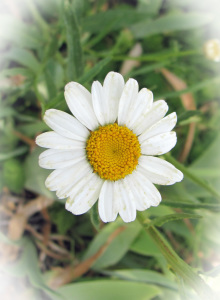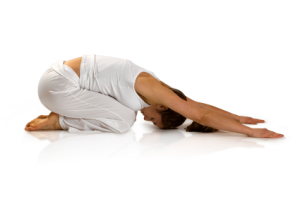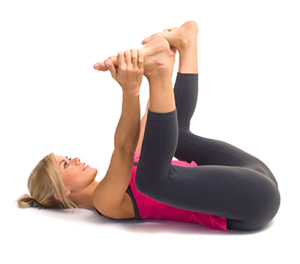 Don’t be fooled by the names of these yoga poses—child’s pose and happy baby are great for all ages. I previously shared how beneficial I believe yoga to be for those with pelvic pain (Go with the yoga flow). Now I want to share my two favorite poses for hypertonic pelvic floor dysfunction: child’s pose and a modified version of happy baby. Both of these poses were recommended by my physical therapist and incorporated into my home therapy long before I ever attended a yoga class. If you have not yet discovered these poses, I hope that you can incorporate them into your own healing practice as well.
Don’t be fooled by the names of these yoga poses—child’s pose and happy baby are great for all ages. I previously shared how beneficial I believe yoga to be for those with pelvic pain (Go with the yoga flow). Now I want to share my two favorite poses for hypertonic pelvic floor dysfunction: child’s pose and a modified version of happy baby. Both of these poses were recommended by my physical therapist and incorporated into my home therapy long before I ever attended a yoga class. If you have not yet discovered these poses, I hope that you can incorporate them into your own healing practice as well.
Child’s pose and modified happy baby are my go-to poses for when I have flare ups of pelvic pain and muscle spasms, and I think you’ll see why. Both poses require you to be laying on the floor, so I recommend a yoga mat, or any open spot of carpet you have in your home. You can always lay a blanket or towel down if your carpet is not soft enough. Another important component that is necessary to gain the full benefits of the poses is to practice yoga breathing (called Ujjayi, meaning ‘victorious’ breath). Ujjayi breathing could take up an entire post of its own, but for now just keep in mind that it is a deep, steady breath through your nose. The inhale and exhale should be even; so slow your inhale down and push your exhale out so that both take the same amount of time. This breath allows plenty of oxygen to flow through your bloodstream, and also helps you focus on overall relaxation.
Child’s pose
 For child’s pose start by kneeling on your mat, near the center, but slightly further towards the bottom rather than the top of the mat. Next, bend forward stretching your arms straight out in front of you towards the top of your mat. Rest your forehead comfortably on the mat (and chest on your lap) while stretching your arms forward and your rear backward, resting on your heels. In a yoga class your instructor will tell you to keep reaching your arms in order to maintain tension, thus strengthening during the stretch. However, I recommend completely releasing any tension in order to gain the full benefits to your pelvic floor.
For child’s pose start by kneeling on your mat, near the center, but slightly further towards the bottom rather than the top of the mat. Next, bend forward stretching your arms straight out in front of you towards the top of your mat. Rest your forehead comfortably on the mat (and chest on your lap) while stretching your arms forward and your rear backward, resting on your heels. In a yoga class your instructor will tell you to keep reaching your arms in order to maintain tension, thus strengthening during the stretch. However, I recommend completely releasing any tension in order to gain the full benefits to your pelvic floor.
There are different variations of child’s pose you can try based on how you position your legs. You can keep your legs close together, or you can spread your knees wide with your toes touching, creating a sort of triangle. Personally, I like spreading my knees and feet an equal distance apart, a tiny bit wider than hip distance. I found that this pose is especially beneficial for when I am experiencing a flare in pain around my coccyx, or tailbone. I will get into this pose, breathe deeply, and focus on relaxing the muscles around my tailbone. To help calm my mind and focus on relaxation I will often count my breaths. You should hold the pose for at least five breaths, but I will often hold for 20-30 breaths depending on how long I need to really stretch and relax my tense pelvic floor muscles.
Happy baby

This is the regular version of happy baby. Modify by bending your knees then grasping your legs rather than feet.
The regular happy baby pose involves you holding onto your feet and rolling on your back from side to side (think of a happy baby playing with his feet). This pose works really well to massage your upper back. However, I recommend a modified version which focuses on stretching and releasing tension in the pelvic floor muscles. Start by laying on your back, then bend your knees and pull them upward and outward. I usually place each hand just below each knee, grasping with my full palm. I then pull my bent knees up and out and rest my arms partially on the floor. You can picture the pose as if you are doing a deep squat, yet lying on your back allowing the stretch to be even deeper because you don’t have to contend with your bottom hitting the floor.
I will admit that happy baby is not the most attractive of poses, and I usually try not to do it in front of a crowd. If you are in yoga class, you can always rotate so your head is at the top of the mat and your feet are pointing towards the wall. But, even if you end up giving a stranger an awkward view, the stretch in your pelvic floor is totally worth it. Modified happy baby is especially great for the area I sit on all day, and even internal vaginal muscles. When I first started this pose after instruction from my PT I could only do it for a short period of time without feeling discomfort. But over time the healing benefits of the stretch have allowed me to hold the pose for long periods. I recommend starting with the goal of holding for five deep breaths, but as your muscles become more accustomed to the stretch you can hold for longer periods (now I rarely hold for less than 20 breaths).
I recommend discussing these stretches with your physical therapist or yoga instructor, and of course never do anything that causes pain! Although I personally have found these very helpful, everyone is different and it is important to listen to your body. The next time your pelvic pain flares, try child’s pose or modified happy baby to see if they help. Both are also good to try after sex to stretch and relax the pelvic floor muscles to help reduce muscles spasms and pain after intercourse. After all, child’s pose and happy baby are for adults too!
*Photo for child’s pose was taken from http://askinyourface.com/2012/11/26/looking-ahead-with-lauren-my-favorite-yoga-poses/yoga-childs-pose-pictures/. Photo for happy baby was taken from http://www.onlineyogaguru.com/ananda-balasana-happy-baby-pose-28/.

Hi! Both these positions really hurt in my hip crease. Is this normal? Should i power through? Thanks jodie
Hi Jodie! Thank you for your comment and I’m glad to hear you are trying out the stretches. I never recommend that you “power through” anything that causes you pain. Pain is your body’s way of telling you that something is wrong. In your case, it may be that your hips have a lot of tension in them which is causing the pain you are feeling. Have you tried a less intense version of these two stretches? For example, in modified happy baby, try keeping your thighs perpendicular to the ground so that you maintain a 90 degree angle with your hips. This might allow you to still receive some of the benefits of the stretch without putting too much pressure on your hips. Don’t be afraid to add props such as pillows or rolled up towels to help you keep the stretches from putting too much pressure on painful areas. You may also want to focus first on relieving some of the tension in your hips before doing these stretches. I will try to share a post soon describing some of the hip opening stretches that have helped me as I too carry a lot of tension in my hips (check out my recent post Open up those hips!). Personally I think the best thing would be to find a qualified physical therapist who can work with you to determine treatment options that are tailored to your body’s needs (a good yoga instructor and/or massage therapist are potential options as well). I wish you well on your journey and I would love to hear how you are doing!